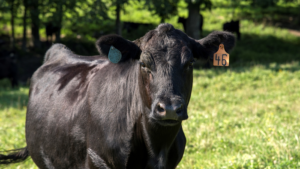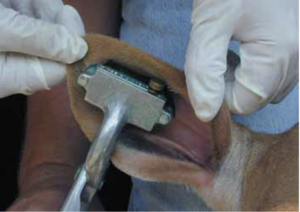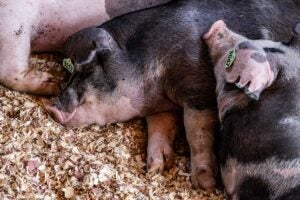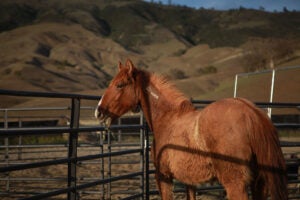Animal identification is an important tool for farmers and ranchers. The basis of identification is so farmers and ranchers can track animals for record keeping purposes. Historically, animal IDs have been used to indicate ownership and prevent animal theft (think brands on cattle and horses).
Today, those are still important reasons for animals to be ID’d, but animal identification is also important for health and food safety reasons. Identification allows us to trace an animal from birth through their entire life cycle and even beyond. Genetic improvements can be monitored through accurate identification.
Identification is also important for animals that are registered or when there is a transfer of ownership. Animals can be accurately tracked, and it means that any new or potential owner can be sure they have the correct animal. Some of the records that can be attached to an animal’s ID include its date of birth, parentage, production records, health history, and owner’s information.
There are two types of identification: permanent and nonpermanent. Just like the name says, permanent IDs stick with an animal through its entire life. Examples include tattooing and ear notching. Non-permanent IDs can be lost or removed from the animal and include things like ear tags.
Here’s a deeper look at many different types of animal IDs:

Ear tags are a very commonly used and easily visible identification. They can be used on cattle, sheep, goats, hogs and other types of animals, but are used most often on cattle. Ear tagging is very similar to people getting their ears pierced. There is a wide variety of companies that make ear tags and their corresponding applicators. The tags are made of a flexible plastic and can be purchased pre-numbered or completely blank. Some farms choose to write/engrave the animals name or number onto the tag. Tags also come in a variety of colors and sizes.
The tags are pierced through the middle of the ear, avoiding the ribs of the ear. Ear tags can be easily seen and read from a distance (some front and back) and are inexpensive. However, ear tags can be ripped from the ear, can be lost/fall out if they’re not applied properly, and can sometimes even fade over time. Many people use ear tags in addition to a more permanent form of identification.

Tattooing is one of the most commonly used forms of permanent animal identification. Tattooing involves imprinting a series of numbers and/or letters that serve as the animal’s identification into the skin, where it will permanently remain. For cattle, goats, sheep, and swine, the tattoo is normally placed above the first rib on the inside of the ear (so you could still place an ear tag below it). Horses can be tattooed on the inside of their lips. Some species can be tattooed in other locations.
Many animals are tattooed because registered animals normally need to be permanently ID’d, and tattooing is generally the best and easiest form of permanent ID. However, tattoos can be hard to read on animals with darkly pigmented ears. You may have to use a flashlight behind the ear to read the ID. In darker colored ears, you need to use an easily visible ink color such as green or white.
Though tattoos serve as an effect method of permanent ID, they can’t be read from a distance. Many farmers and ranchers who tattoo also ear tag so they have a second, more visible type of ID.

Ear notching is widely used in the swine industry. The pigs ears are “notched” by a special tool. The notches, which are small v-shaped sections, correspond to the pig’s litter number and individual pig number. The little number is notched into the pig’s right ear, and the individual pig number is notched into the pig’s left ear. In combination, these two numbers give each pig a unique ID number.
Notching causes minimal stress to the animal and completely heals in about a week. Pigs are generally notched in their first few days after birth. Ear notching can be difficult to read without some practice.

Branding and freeze branding are also used to identify some animals. Brands tend to be more easily visible, like ear tags, and are permanent. Branding and freeze branding is most commonly used for cattle and horses.
Another important consideration of identifying an animal is health, cleanliness, and biosecurity. Since most methods of applying ID require some type of puncture through/into the skin, it’s important to disinfect the area you are going to apply the ID to, disinfect your equipment between each use, and monitor the animal as it heals. This keeps animals (and people) healthy and safe.
Today there is an increasing amount of electronic identification. Electronic ear tags, microchips, and collars keep track of information about an animal electronically. These types of ID can also be used to automatically dispense feed to animals, keep track of production information for dairy animals, and information can be easily and quickly located about animals. Electronic ear tags are also called EID and RFID (radio frequency identification) tags.
The type of identification used on an animal depends greatly on the size of the farm or ranch, what data and records the producer wants to keep, what species is being ID’d, and what the animal will be used for, among other factors. There are also more practical things to consider when choosing an ID method, such as the cost of the ID system, what equipment you need, the application method, how visible the ID is, how permanent you want your ID to be, and more.
Most animals are ID’d at or shortly after birth. It is often easiest to apply the identification when the animal is younger and it allows the farmer or rancher to keep track of the animal immediately.
Identification can also play an important role in disease traceability. One example of this is the National Scrapie Eradication Program (NSEP). Nearly all sheep and goats in the United States are required to be officially identified before they enter interstand commerce or if ownership of the animal changes. These IDs can be tattoos or ear tags (there’s still some restrictions around tattooing). Thanks in part to official identification, the NSEP program has eliminated scrapie from 99 percent of U.S. sheep and goats. This is just one example of how IDs can be an important tool in disease prevention and traceability.
There’s a lot more to identifying animals, but at the end of the day, identification is important for record-keeping, tracking diseases, to indicate ownership and more. There are a variety of types of IDs that work differently for different animals and operations. Many farmers and ranchers use multiple types of identification and most registered animals are required to have permanent identification.
Next time you’re looking at livestock, take a look at the wide range of options available to identify animals.
Michelle Miller, the Farm Babe, is a farmer, public speaker, and writer who has worked for years with row crops, beef cattle, and sheep. She believes education is key in bridging the gap between farmers and consumers.



